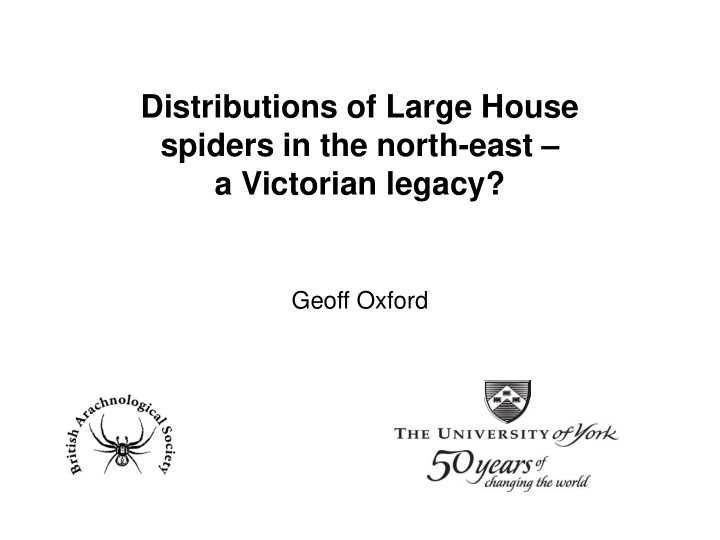



Distributions of Large House spiders in the north-east – a Victorian legacy? Geoff Oxford
Species of Tegenaria in the British Isles associated with human habitation * * * Oxford (2011) British Wildlife 23 : 34-41.
The ‘fishing’ technique
T. gigantea/saeva Pre-1974 county boundaries Bristowe 1939
T. gigantea/saeva Bristowe 1939 Locket, Millidge & Merrett 1974
T. gigantea/saeva Bristowe 1939 Locket, Millidge & Merrett 1974 Merrett 1980
T. gigantea/saeva Bristowe 1939 Locket, Millidge & Merrett 1974 Merrett 1980 Harvey, Nellist & Telfer 2002
T. gigantea/saeva Bristowe 1939 Locket, Millidge & Merrett 1974 Merrett 1980 Harvey, Nellist & Telfer 2002 SRS maps 2006
T. domestica Bristowe 1939
Distributions of Tegenaria saeva , T. gigantea and their hybrids in Britain
Distributions of T. saeva and T. gigantea around 1900 T. saeva T. gigantea Area of overlap Oxford (2009) Bull. Br. arachnol. Soc . 14 : 297-302
Tegenaria atrica in the British Isles http://www.flickr.com/photos/nuclearlakeside Oxford, G. S. & Chesney, H. C. G. (1994)
= Tegenaria gigantea = T. saeva = T. atrica = T. saeva/T. gigantea hybrids
= Tegenaria gigantea = T. saeva = T. atrica = T. saeva/T. gigantea hybrids
= T. atrica Original Burnopfield location
= T. atrica = T. atrica + others = T. gigantea and/or saeva Jesmond 1887 (Hull, 1896) Winlaton 18?? (Hull, 1896) Axwell Park 1910 (Bagnell & Turner, 1913)
A prophetic statement …? ‘ The 14 years or more between Hull’s Winlaton specimen and those from Axwell Park suggest that a viable population may have been established in this area around the turn of the twentieth century .’ (Oxford, 2009, p.298)
Implications 1. Some T. atrica records from northern Britain might have resulted from local movement rather than foreign imports e.g. Low Newton, near Craster (1996). 2. There may be competitive exclusion within the Tegenaria atrica group such that once one species is well-established, it is difficult for others to invade. 3. This might also be a factor preventing fusion at the boundary between T. saeva and T. gigantea in the south. 4. However, it is difficult to imagine exactly how this competitive exclusion might work. 5. Without the original specimens from the Newcastle area, it is impossible to prove the idea of a Victorian legacy, but it’s the best bet so far!
… any questions?
Recommend
More recommend